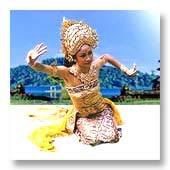Life in Bali is very communal with the organization of villages, farming and even the creative arts being decided by the community. The local government is responsible for schools, clinics, hospitals and roads, but all other aspects of life are placed in the hands of two traditional committees, whose roots in Balinese culture stretch back centuries. The first, Subak, concerns the production of rice and organizes the complex irrigation system.
Everyone who owns a sawah, or padi field, must join their local Subak, which then ensures that every member gets his fair distribution of irrigation water. Traditionally, the head of the Subak has his sawah at the very bottom of the hill, so that the water has to pass through every other sawah before reaching his own. The other community organization is the Banjar, which arranges all village festivals, marriage ceremonies and cremations, as well as a form of community service known as Gotong Royong.
Most villages have at least one Banjar and all males have to join one when they marry. Banjars, on average, have a membership of between 50 to 100 families and each Banjar has its own meeting place called the Bale Banjar. As well as being used for regular meetings, the Bale (pavilion) is where the local gamelan orchestras and drama groups practice.
 Each stage of Balinese life is marked by a series of ceremonies and rituals known as Manusa Yadnya. They contribute to the rich, varied and active life the average Balinese leads.
Each stage of Balinese life is marked by a series of ceremonies and rituals known as Manusa Yadnya. They contribute to the rich, varied and active life the average Balinese leads.
Birth
The first ceremony of Balinese life takes place even before birth. Another ceremony takes place soon after the birth, during which the afterbirth is buried with appropriate offerings. The first major ceremony takes place halfway through the baby's first Balinese year of 210 days.
Names
Basically the Balinese only have four first names. The first child is Wayan or Putu, the second child is Made or Kadek, the third is Nyoman or Komang and the fourth is Ketut. The fifth, sixth, seventh, eighth and ninth will be another Wayan, Made, Nyoman, Ketut and Wayan again.
Childhood
The Balinese certainly love children and they have plenty of them to prove it. Coping with a large family is made much easier by the policy of putting younger children in the care of older ones. After the ceremonies of babyhood come ceremonies marking the stages of childhood and puberty, including the important tooth-filing ceremony.
Marriage
Every Balinese expects to marry and raise a family, and marriage takes places at a comparatively young age. Marriages are not, in general, arranged as they are in many other Asian communities although strict rules apply to marriages between the castes. There are two basic forms of marriage in Bali - mapadik and ngorod. The respectable form, in which the family of the man visit the family of the woman and politely propose that the marriage take place, is mapadik. The Balinese, however, like their fun and often prefer marriage by elopement (ngorod) as the most exciting option. Of course, the Balinese are also a practical people so nobody is too surprised when the young man spirits away his bride-to-be, even if she loudly protests about being kidnapped. The couple go into hiding and somehow the girl's parents, no matter how assiduously they search, never manage to find her. Eventually the couple re-emerge, announce that it is too late to stop them now, the marriage is officially recognized and everybody has had a lot of fun and games. Marriage by elopement has another advantage apart from being exciting and mildly heroic it's cheaper.
The Household
There are many modern Balinese houses, but there are still a great number of traditional Balinese homes. The streets of Ubud; nearly every house will follow the same traditional walled design.
Men & Women
There are certain tasks clearly to be handled by women, and others reserved for men. Social life in Bali is relatively free and easy. In Balinese leisure activities the roles are also sex differentiated. Both men and women dance but only men play the gamelan. Today you do see some women painters, sculptors, and woodcarvers.
Community Life
Balinese have an amazingly active and organized village life. You simply cannot be a faceless nonentity in Bali. You can't help but get to know your neighbors as your life is so entwined and interrelated with theirs.
Death & Cremation
There are ceremonies for every stage of Balinese life but often the last ceremony-cremation-is the biggest. A Balinese cremation can be an amazing, spectacular, colorful, noisy and exciting event. In fact it often takes so long to organize a cremation that years have passed since the death. During that time the body is temporarily buried. Of course an auspicious day must be chosen for the cremation and since a big cremation can be very expensive business many less wealthy people may take the opportunity of joining in at a larger cremation and sending their own dead on their way at the same time. Brahmans, however, must be cremated immediately. Apart from being yet another occasion for Balinese noise and confusion it's a fine opportunity to observe the incredible energy the Balinese put into creating real works of art which are totally ephemeral. A lot more than a body gets burnt at the cremation. The body is carried from the burial ground (or from the deceased's home if it's an 'immediate' cremation) to the cremation ground in a high, multi-tiered tower made of bamboo, paper, string, tinsel, silk, cloth, mirrors, flowers and anything else bright and colorful you can think of. The tower is carried on the shoulders of a group of men, the size of the group depending on the importance of the deceased and hence the size of the tower. The funeral of a former rajah high priest may require hundreds of men to tote the tower.A long the way to the cremation ground certain precautions must be taken to ensure that the deceased's spirit does not find its way back home. Loose spirits around the house can be a real nuisance. To ensure this doesn't happen requires getting the spirits confused as to their whereabouts, which you do by shaking the tower, running it around in circles, spinning it around, throwing water at it, generally making the trip to the cremation ground anything but a stately funeral crawl. Meanwhile, there's likely to be a priest halfway up to tower, hanging on grimly as it sways back and forth, and doing his best to soak bystanders with holy water. A gamelan sprints along behind, providing a suitably exciting musical accompaniment. Camera-toting tourists get all but run down and once again the Balinese prove that ceremonies and religion are there to be enjoyed. At the cremation ground the body is transferred to a funeral sarcophagus, this should be in the shape of a bull for a Brahmana, a winged lion for a Satria and a sort of elephant-fish for a Sudra. These days, however, almost anybody from the higher castes will use a bull. Finally up it all goes in flames funeral tower, sarcophagus, body, the lot. The eldest son does his duty by poking through the ashes to ensure that there are no bits of body left unburned. And where does your soul go after your cremation? Why, to a heaven which is just like Bali!
Read more...















































